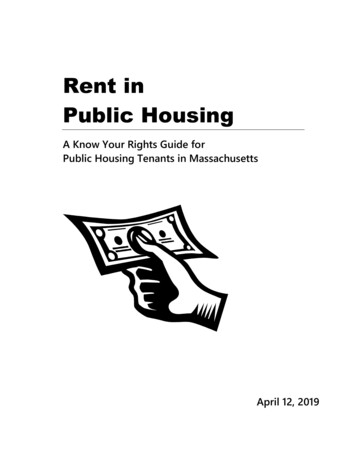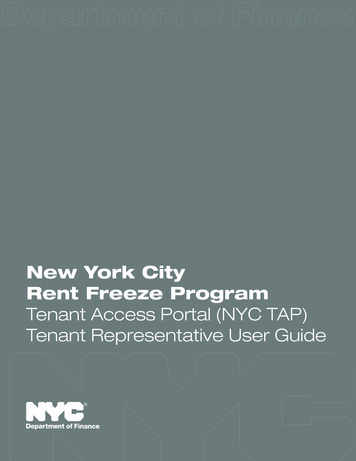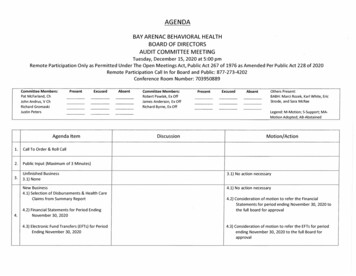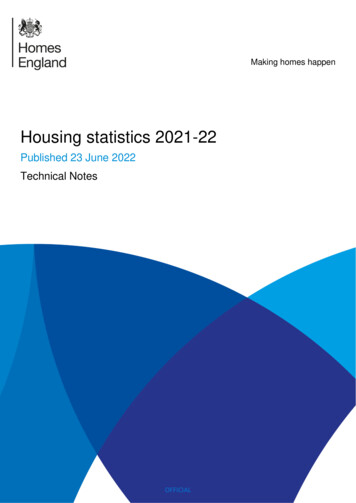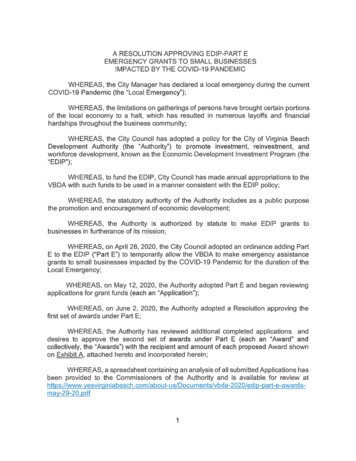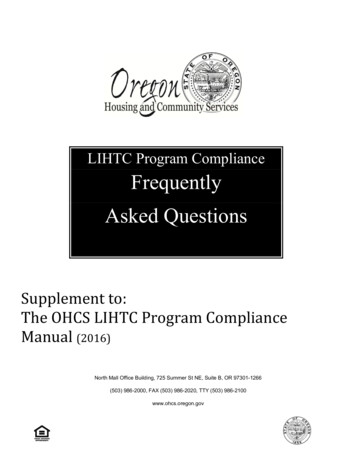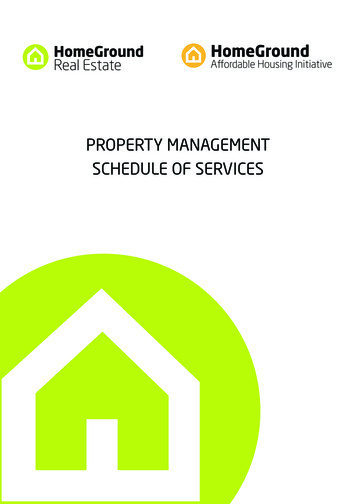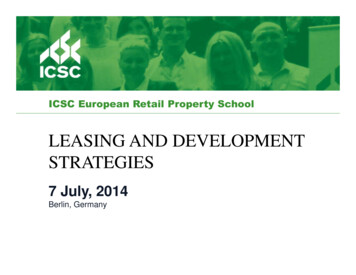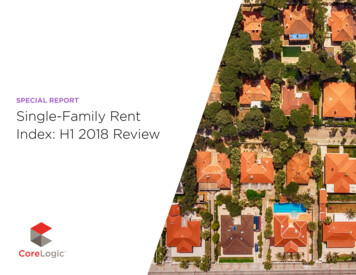
Transcription
SPECIAL REPORTSingle-Family RentIndex: H1 2018 ReviewFEBRUARY 20181
NationalOverview“Single-family rentals make upone-half of all residential rentals butare an overlooked segment of thehousing market. Much like the restof the housing market, single familyrentals are affected by market forcesand fell rapidly during the GreatRecession. They have since bouncedback strongly from their low point in2010, mirroring house price growth.MOLLY BOESEL,PRINCIPAL ECONOMIST AT CORELOGIC 2018 CoreLogic — This material may not be reproduced in any form without express written permission.2
NationalOverviewSince January 2018, the national Single-Family RentIndex (SFRI) increased 4.1 percent.* Low rental homeinventory, relative to demand, fuels the growth ofsingle-family rent prices. The SFRI shows that singlefamily rent prices have climbed between 2010 and2018. However, year-over-year rent price increaseshave slowed since February 2016, when they peakedat 4.2 percent, and have stabilized in the first half of2018 with an average year-over-year increase of2.8 percent.Housing CrisisEffects Linger4.1%the national Single-Family RentIndex cumulative increasesince January 2018During the Great Recession, American households lostmore than 16 trillion in net worth and national homeprices fell sharply. National single-family rental pricespeaked in August 2008, falling 5.7 percent to theirlow point in January 2010.As analyzed in the CoreLogic Special Report,Evaluating the Housing Market Since the GreatRecession, most of the markets that experiencedthe largest peak-to-trough home price drops duringthe housing crisis also saw the most extremetrough-to-peak growth rates as the market stabilized,including Nevada, Florida and Arizona.This trend has been reflected in the single-familyrental market. Las Vegas has consistently led thenation in year-over-year rent price increases sincethe start of 2018, followed closely by Orlandoand Phoenix. CoreLogic economists attribute thisin part to investor purchases of single-family homesreturning to the market as single-family rental homes,especially in areas hit hard by the housing crisis.2.8%the average year-over-yearrent price increase duringthe first half of 2018Source: CoreLogic December 2017*The H1 growth rate represents cumulative monthly growth for January to June 2018 2018 CoreLogic — This material may not be reproduced in any form without express written permission.3
TABLE 1: SINGLE-FAMILY RENT CHANGE FOR SELECT GEOGRAPHICAL AREAS DURING THE FIRST HALF OF 2018*Core-BasedStatistical AreaJanuary 2018Single-FamilyYear-Over-YearRent ChangeFebruary 2018Single-FamilyYear-Over-YearRent ChangeMarch 2018Single-FamilyYear-Over-YearRent ChangeApril 2018Single-FamilyYear-Over-YearRent ChangeMay 2018Single-FamilyYear-Over-YearRent ChangeJune 2018Single-FamilyYear-Over-YearRent ChangeNational2.72.72.72.92.93.0Atlanta-Sandy Springs-Roswell, GA3.8%3.6%3.8%4.1%3.9%4.0%Austin-Round Rock, TX1.3%1.4%1.7%1.9%2.0%2.5%Boston, ia, lington Heights, IL0.7%0.9%0.7%1.1%1.3%1.6%Dallas-Plano-Irving, , MI1.3%2.1%1.7%2.2%1.9%2.5%Houston-The Woodlands-Sugar Land, TX2.7%2.7%3.4%4.2%4.4%3.9%Las Vegas-Henderson-Paradise, NV4.8%5.2%5.4%5.8%5.6%5.7%Los Angeles-Long Beach-Glendale, CA3.3%3.4%2.8%2.7%2.8%3.2%Miami-Miami Beach-Kendall, d, FL4.7%5.1%5.2%5.2%5.4%5.7%Philadelphia, PA1.0%0.4%0.3%1.9%2.2%2.4%Phoenix-Mesa-Scottsdale, AZ4.6%4.5%4.8%4.9%4.9%4.7%San Diego-Carlsbad, , WA1.4%0.4%1.0%2.7%3.0%1.7%St. Louis, MO-IL0.5%1.3%1.7%2.1%1.3%1.5%Tucson, AZ4.1%3.8%4.7%4.8%3.9%3.8%Urban Honolulu, -Alexandria, DC-VA-MD-WV1.1%1.4%2.0%2.0%2.0%1.9%*When necessary, year-over-year data was revised. Revisions are standard, and to ensure accuracy CoreLogic incorporates newly released data to provide updated results. 2018 CoreLogic — This material may not be reproduced in any form without express written permission.4
The High-EndMarket ComebackHigh-end rentals, defined as properties with rentprices greater than 125 percent of a region’s medianrent, saw higher cumulative rent growth of 4.2 percentfrom January 2018 to June 2018.* Rent price increasesamong low-end rentals – properties with rent pricesless than 75 percent of the regional median – totaled3.4 percent since January 2018.*However, low-end rentals have continued to outpacethe high-end cohort in year-over-year rent priceincreases due to low supply and increased demand.The year-over-year rate of increase for low-end rentprices has slowed while growth rates for the high-endbegin to accelerate, signaling a stabilization in thelow-end market.4.2%3.4%cumulative rent growth forhigh-end rentals duringthe first half of 2018cumulative rent growth forlow-end rentals duringthe first half of 2018FIGURE 1: NATIONAL SINGLE-FAMILY RENT INDEX YEAR-OVER-YEAR PERCENT CHANGE BY PRICE TIER*The H1 growth rate represents cumulative monthly growth for January to June 2018 2018 CoreLogic — This material may not be reproduced in any form without express written permission.5
When DisasterStrikesThe 2016 hurricane season took a toll on the rentalmarket in many coastal metro areas. For a 17-monthperiod beginning in May 2016, the Houston metro areaexperienced decreasing year-over-year rent prices.The market saw its first increase of 1.1 percent inOctober 2017 and has continued to show impressiveyear-over-year increases in the first half of 2018,peaking at 4.4 percent in May 2018 and settlingat 3.9 percent in June 2018.3.3%3.5%cumulative rent growthfor Houston duringthe first half of 2018average year-over-yearrent price increase duringthe first half of 2018While this year-over-year growth rate signals thecontinued recovery for the disaster-struck area,Houston’s cumulative growth for the first half of2018 remained among the lowest of the 20analyzed metros at 3.3 percent.FIGURE 2: DISASTER IMPACT - HOUSTON RENT PRICE CHANGES 2016-2018 2018 CoreLogic — This material may not be reproduced in any form without express written permission.6
Looking Forward to theSecond Half of 2018Increasing home prices across the nation may bea factor in rental demand. According to the latestCoreLogic Home Price Index (HPI), national homeprices increased 6.8 percent year over year fromJune 2017 to June 2018. While younger millennialrenters (those under the age of 29) are significantlymore likely to want to buy a home in the next12 months, according to a new consumer survey fromCoreLogic and RTi Research, affordability remainsa significant issue. Sixty-three percent of this agecohort identified the inability to afford a home ordown payment as the reason they are not interestedin buying at this time. With home prices projected toincrease by 5.1 percent year over year from June 2018to June 2019, national rent growth is also expected tocontinue its upward trend.“High demand and low supply of lowerpriced single-family rental propertiescontinue to push up rents for this segmentof the rental market. With these marketforces expected to stay in place in thenear term, rents on lower-priced rentalproperties should continue to outpacethose of higher-end rental properties.MOLLY BOESEL,PRINCIPAL ECONOMIST AT CORELOGIC 2018 CoreLogic — This material may not be reproduced in any form without express written permission.7
MethodologyThe CoreLogic SFRIThe single-family rental market accounts for half of the rentalhousing stock, yet unlike the multifamily market, which has manydifferent sources of rent data, there are minimal quality adjustedsingle-family rent transaction data. The CoreLogic Single-FamilyRent Index (SFRI) serves to fill that void by applying a repeatpairing methodology to single-family rental listing data in theMultiple Listing Service. CoreLogic constructed the SFRI for over70 Core-Based Statistical Areas (CBSAs)—including 40 CBSAswith four value tiers—and a national composite index.The CoreLogic HPI The CoreLogic HPI is built on industry-leading public record,servicing and securities real-estate databases, and incorporatesmore than 40 years of repeat-sales transactions for analyzinghome price trends. Generally released on the first Tuesday ofeach month (with an average five-week lag), the CoreLogic HPIis designed to provide an early indication of home price trendsby market segment and for the “Single-Family Combined” tier.The report represents the most comprehensive set of properties,including all sales for single-family attached and single-familydetached properties. The indexes are fully revised with eachrelease and employ CoreLogic valuation techniques to signalturning points in the market sooner than other reports. TheCoreLogic HPI provides measures for multiple market segments(referred to as tiers) based on property type, price, time betweensales, loan type (conforming vs. non-conforming) and distressedsales. Broad national coverage is available from the national leveldown to ZIP Code, including non-disclosure states.Source: CoreLogicThe data provided is for use only by the primary recipient or theprimary recipient’s publication or broadcast. This data may notbe re-sold, republished or licensed to any other source, includingpublications and sources owned by the primary recipient’s parentcompany without prior written permission from CoreLogic. AnyCoreLogic data used for publication or broadcast, in whole orin part, must be sourced as coming from CoreLogic, a data andanalytics company. For use with broadcast or web content, thecitation must directly accompany first reference of the data. Ifthe data is illustrated with maps, charts, graphs or other visualelements, the CoreLogic logo must be included on screen orwebsite. For questions, analysis or interpretation of the data,contact Alyson Austin at newsmedia@corelogic.com or AllyseSanchez at corelogic@ink-co.com. Data provided may not bemodified without the prior written permission of CoreLogic. Donot use the data in any unlawful manner. This data is compiledfrom public records, contributory databases and proprietaryanalytics, and its accuracy is dependent upon these sources.AboutCoreLogicCoreLogic (NYSE: CLGX) is a leading global propertyinformation, analytics and data-enabled solutionsprovider. The company’s combined data from public,contributory and proprietary sources includes over4.5 billion records spanning more than 50 years andproviding detailed coverage of property, mortgagesand other encumbrances, consumer credit, tenancy,location, hazard risk and related performanceinformation. The markets CoreLogic serves includereal estate and mortgage finance, insurance, capitalmarkets, and the public sector. CoreLogic delivers valueto clients through unique data, analytics, workflowtechnology, advisory and managed services. Clientsrely on CoreLogic to help identify and manage growthopportunities, improve performance and mitigate risk.Headquartered in Irvine, Calif., CoreLogic operates inNorth America, Western Europe and Asia Pacific.For more information, please visit www.corelogic.com.CORELOGIC, the CoreLogic logo, CoreLogic HPI and CoreLogic HPI Forecast are trademarks of CoreLogic, Inc.and/or its subsidiaries. All other trademarks are the property of their respective owners.The use of the enhanced CoreLogic HPI was implemented withthe Equity report in the second quarter of 2016. Only data formortgaged residential properties that have a current estimatedvalue are included. There are several states or jurisdictionswhere the public record, current value or mortgage datacoverage is thin and have been excluded from the analysis.However, these instances account for fewer than 5 percentof the total U.S. population. 2018 CoreLogic — This material may not be reproduced in any form without express written permission.8
For an expanded perspective on housingeconomies and property markets, visit theCoreLogic Insights Blog and follow us on: 2018 CoreLogic, Inc. All rights reserved. CORELOGIC and theCoreLogic logo are trademarks of CoreLogic, Inc. and/or its subsidiaries.All other trademarks are the property of their respective holders.9
and Phoenix. CoreLogic economists attribute this in part to investor purchases of single-family homes returning to the market as single-family rental homes, especially in areas hit hard by the housing crisis. 2.8% the average year-over-year rent price increase during the first half of 2018 4.1% the national Single-Family Rent
